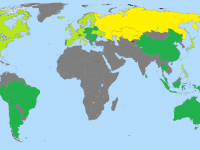Creating relations between characters is essential to larp. The interaction between the characters dictates how the story unfolds and what kind of experience the players end up creating. Sometimes these pretend relations leave a lasting impression on the players, which can be expressed for example as bleed or the foundation of real-life friendships.
YARN is a method intended to support both organizers and players in their relation building process. The method focuses on building relations containing dramatic options to generate different forms of drama between the involved characters, as well as their surrounding relations. Rather than defining a relation as being either negative or positive, YARN combines both positive and negative aspects into a single relationship. By doing so, the relations will contain a dramatic tension that can be exploited to achieve:
- Organic and realistic relations
- Options for drama and conflict which the players can tap into
- A constant tension that can create more drama and conflict
- A starting point for the characters’ play together
At its core, the built relations will contain two elements: An emotional bond, that defines the magnitude and type of the relation, and a conflicting element, that defines the center of the relation drama.
YARN Relation Building
First of all, YARN relations are a cooperative effort. Therefore, the relation building must be seen as a dialogue, either between the involved players, between the organizers in charge of creating the relations, or between the organizers and players (or all of the above). This is to ensure different kinds of input, generating new ideas and thereby creating nuanced relations not entirely based on archetypes or tropes, as well as the option for negotiating the built relation.
Secondly, YARN is based on an alternate version of the collaborative improv principle ”Yes… And…”. Instead of this term, YARN uses the expression “Yes… But…”, thereby focusing on the conflicting element in the relation being built.

The starting point of the relation building dialogue will be to find or create the characters’ common ground (the Yes…). The common ground is what binds the characters together, defines their emotional bond and gives them a reason for interacting with each other. The common ground can for example be the relation type (e.g. family, friends, lovers, neighbors), the network, community or group the characters belong to (e.g. school class, cult, workplace, friend group), or what they have in common as persons (e.g. interests, hobbies, talents, dreams, ambitions). While the first two (relationship type and network/community group) can be considered highly descriptive, the last one can be very personal to the characters, and as such create many options for drama during the larp. The characters’ common ground can be based on several of these examples, creating the type and depth of the bond between the characters.
The next step is to define what would spark a conflict between the characters (the But…). This could for example be a change in the status quo (external and uncontrolled change: a fellow family member dies, one of the characters gets fired, their community gets separated), the characters’ actions (internal and controlled change: one character breaks with the other, cheats in a competition, decides to run for office), or other relations (friends or parents against characters’ relation, boss prefers one over the other, one character is building a relation with someone new). This conflict can either be a part of the characters’ backgrounds or something that will happen during the larp, being agreed on or staged beforehand.
The YARN Relation Building Summarized
- Create relations as a dialogue
- Find the characters’ common ground
For example:- Relation type
- Network, community or group
- Interests, hobbies, talents, dreams, ambitions
- What would spark a conflict?
For example:- Change in status quo
- The characters’ actions
- Other relations
These steps constitute the YARN relation building. They can be used either on their own in the relation building process, or they can be employed as a part of a relation building workshop before the larp, as described below.
YARN Workshop
Practical Information
To host this workshop, you will need a ball of yarn for each workshop group (app. 2m of yarn for each relation, depending on group size). The yarn has both a visual, tactile and mediating function, and for symbolic reasons red yarn is recommended as it will create both a figurative and literal “red thread” between the characters.
A workshop group needs to consist of at least two people and can be as large as needed, but it is recommended to create groups around the size of 4-7 people. This is due to logistical reasons (such as time and physical space), to keep it as a collaborative process, as well as for the sake of the participants’ ability to remember the relations being made.
Allow at least 1 minute per group member for introduction of characters (if the characters are unknown to each other beforehand) and minimum 2 minutes for each relation.
Example: A group of 5 would need app. 20m yarn and at least 25 minutes for the workshop.
How to Run the Workshop
Divide the participants in groups and give each group a ball of yarn. The groups can either be randomized or thematically chosen, based on the relation groups of the larp (e.g. the different families, friend groups, societies, etc.).
The group settles in a circle facing each other. Every participant gives a very short introduction of their character (name, function and position in group, etc.).
The relation building is a collaborative process between the group members. One participant starts by taking the yarn and, while holding on to one end of it, throws the ball to another participant in the circle. This creates a thread between the two participants. The participant throwing the yarn then states the common ground for the two characters (the Yes…). If the groups are thematically chosen, the common ground related to the characters’ relation type and group affiliation might already be decided. In that case, focus instead on the personal common ground (e.g. interests, hobbies, talents, dreams, ambitions). Everyone in the group can suggest ideas or thoughts on the relation, but as a rule, the definition right is with the one who threw the ball of yarn. The participant who has received the yarn then states the conflicting element in the relation (the But…), as before, suggestions from the group are encouraged, but the definition right is with the participant now holding the yarn. Note: all players involved in the relation has the right to decline any suggestion or change it to something they are comfortable with by applying the “But…”
When the first relation has been made, the participant with the yarn keeps a hold on the thread and throws the ball to another participant, thereby creating another thread and another relation. This process continues until each participant has a relation to everyone in their group, creating a visual network of yarn and relations (e.g. in a group of five, every participant will end up with four relations). Note that groups with an even number of participants will have to re-throw the yarn to some of its participants to ensure everyone gets relations to each other in the group.

The YARN Workshop Summarized
- Divide participants into groups and distribute yarn
- Group settles in a circle facing each other
- First participant throws yarn to another group member, defining “the Yes…”
- Receiving participant defines “the But…”
- The process continues as the yarn is thrown to another group member
- The workshop ends with a finished network of yarn between participants
- The PDF version of YARN can be found here: YARN.pdf
- For other pre-larp techniques using yarn, see for example the ball of yarn technique
Cover photo by Nór Hernø.
Edited by Elina Gouliou.






